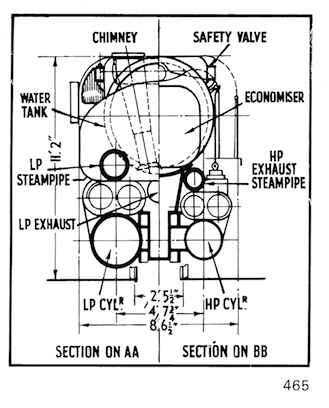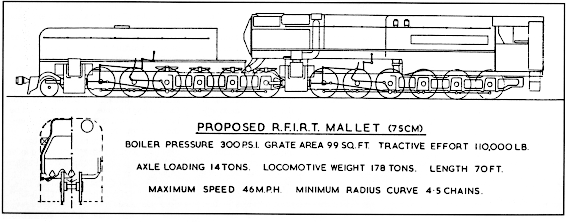|
| These 2' 5-1/2" gauge 2-10-2's
were built in the 50's and
1960's by Mitsubishi Heavy
Industries of Japan for service
on the Rio Turbio Railway in
Argentina, at the southern tip
of South America. The first
batch of engines, present when
Porta arrived, proved highly
capable and quickly displaced
older 2-8-2's. However, Porta
soon set about the systematic
modification of these engines to
improve their efficiency, power,
and availability. So successful
were these modifications that
when additional engines were
ordered in the 1960's, these
refinements and others were
incorporated in their
construction. As a result of
these developments, the Rio
Turbio 2-10-2's were one of the
most efficient groups of steam
locomotives ever operated. Tests
document that the engines
routinely achieved 12%
efficiency, nearly equaling
Chapelon's famed 4-8-0's, and
could attain up to 15%
efficiency under controlled
conditions. Furthermore, their
routine day-to-day efficiency,
including idle time, was much
higher than that attained by
previous engines. Read more
about these locomotives here: Steam
Locomotives of the RFIRT. |
![[Rio Turbio 2-10-2]](pics/rio2.jpg)
photo by Ron Johnson
| These engines feature gas
producer fireboxes, Kylpor
exhaust systems, and massive
6-axle tenders which contain
mostly coal. Auxiliary tenders
provide ample water capacity for
extended runs. Aside from the
major modifications to these
engines, Porta developed
numerous detail design
improvements on these engines.
4-6-2 #4674photo from
the Richard
Campbell collection 4-6-2 #4674 was a project to show that the plentiful low-grade coal from the mines at Rio Turbio could be used in coal burning locomotives for all of Argentina. This engine was originally designed and built to burn imported high-BTU Welsh coal (similar in characteristics to U.S. Pocahontas coal). Using his Gas Producer Combustion System, Porta successfully converted the engine to operate on Rio Turbio coal (very similar to the low-grade coal burned in the Union Pacific's locomotives), while maintaining the same performance it had achieved with the original fuel. Porta achieved his successes through careful attention to small details and by the application of strict engineering principles to steam locomotive design. No single change could produce dramatic improvements; Porta applied many small improvements to areas that had been ignored before. These included items such as water treatment, lubrication, materials, servicing techniques, mechanical fasteners, and others. Not only was power and efficiency greatly increased, but maintenance was greatly reduced and the operator's jobs were made easier. After a few years at the Rio Turbio, Porta moved back to Buenos Aires to join the Instituto Nacional de Tecnologica Industrial (INTI) where he became the head of the thermodynamics department. At INTI, Porta was able to devote time to thinking about the next generation of steam locomotives. In 1969, the railways in Argentina seemed to suffer an epidemic of water quality problems, and they asked for Porta's assistance. 4-8-2 No. 1802 of the Belgrano Railway was chosen as a test engine, and Porta developed an on-board water treatment system based on the French TIA system. The water treatment system was so successful that it was eventually possible to operate the engine with boiler wash-outs only twice in a full year. The engine was also modified by Porta with multiple improvements, including improved exhaust, improved valve events, and a high adhesion tire profile.
Ferrocarril
Belgrano 4-8-2 #1802 (Baldwin
73545)
|
![[Proposed
2-12-12-0]](RT%202-12-12-0.png)


| Porta proposed several new
designs for steam locomotives
for various railway inquiries in
the 1960's and 1970's,
incorporating his principals for
greatly increased efficiency,
reliability, and power. One
proposal was a roller bearing, 3
cylinder compound meter gauge
2-10-0 for Argentina. Before
anyone had heard of ACE, Porta
had laid out a ultra-high
pressure (850 PSIG), 3 cylinder,
triple expansion compound 2-10-0
for U.S. fast freight service.
Bigger engines were considered
for the Rio Turbio to provide
power to move much longer coal
trains. Initially, 2-10-10-2
mallets were proposed, but as
the design was fine-tuned it
evolved into the monster shown
above. These massive 2-12-12-0's
were proposed as replacements
for the 2-10-2's in the 1970's
to allow far heavier trains to
be operated, and a contract to
construct them in Argentinian
shipyards was almost let.
Unfortunately, changed
circumstances killed the
project. Other arrangements were
proposed for new locomotives
even including a massive
Mallet-Garratt, but none of
these ever came to fruition.
Porta's 2-10-2's were doing the majority of the work on this remote rail line until November 1996 when they were gradually replaced by imported diesels. For more information on these engines go here: Steam Locomotives of the RFIRT
Proposed "Third Generation" 2-10-0 for U.S. Fast Freight Service (~1978) By 1980, Porta had developed a clear philosophy of steam design based on his over 30 years of work in the field. Porta's concept was that steam development could be broken down into three classes: 1- First Generation Steam (FGS)- Steam locomotives which had been previously built. He viewed the French designs as being the climax thermodynamically, while he considered American engines the best mechanically. No engines in existence had ever incorporated all of the proven concepts of FGS. 2- Second Generation Steam (SGS)- Steam locomotives which could be built immediately with little or no research and development, which would incorporate and maximize all proven thermodynamic principals for improved performance, plus state-of-the-art materials, design methods, and construction techniques. 3- Third Generation Steam (TGS)- Steam locomotives which would incorporate advanced concepts which would require significant research and development, best acquired through trials on SGS locomotives. Porta felt that many existing steam locomotives could be significantly improved with the limits of FGS. He also believed that SGS locomotives could successfully compete on modern railroads, if they were given modern servicing facilities (as developed in the U.S. by the Norfolk & Western Railway) and if proper maintenance and operating techniques were used, which were equally important to good design. In 1980, Porta was called in by American Coal Enterprises as the foremost authority on steam locomotive development. See the ACE page for information. Other steam projects in the
1980's were performed by
Porta. The railways of
Paraguay, which operate a
fleet of wood-burning
locomotives, called him in to
assist in modernizing their
railways. At least one engine
was modified with a GPCS
adapted for wood and other
improvements. Later, Porta
moved on to Brazil to the
famous Donna Teresa Christina
coal-hauling railway. This
railway was famous for its
fleet of U.S. built meter
gauge 2-10-4's. By the early
1980's, the 2-10-4's had worn
out beyond the ability of the
railways to rebuild them, and
European built 2-10-2's were
imported from other parts of
South America. Porta was
called in to see if the smoke
emissions of the line's
locomotives could be reduced.
Naturally, the GPCS was just
the answer to this, and one
2-8-2 and several of the
2-10-2's were so modified.
Unfortunately, demand for coal
from the mines has evidently
declined in recent years and
no further locomotives were
modernized.
photo by Gary Bensman Cuban 2-8-0 No. 1816during construction
No. 1816 after
completion on display at
"Ecovapor 1999" photo by Shaun McMahon
|